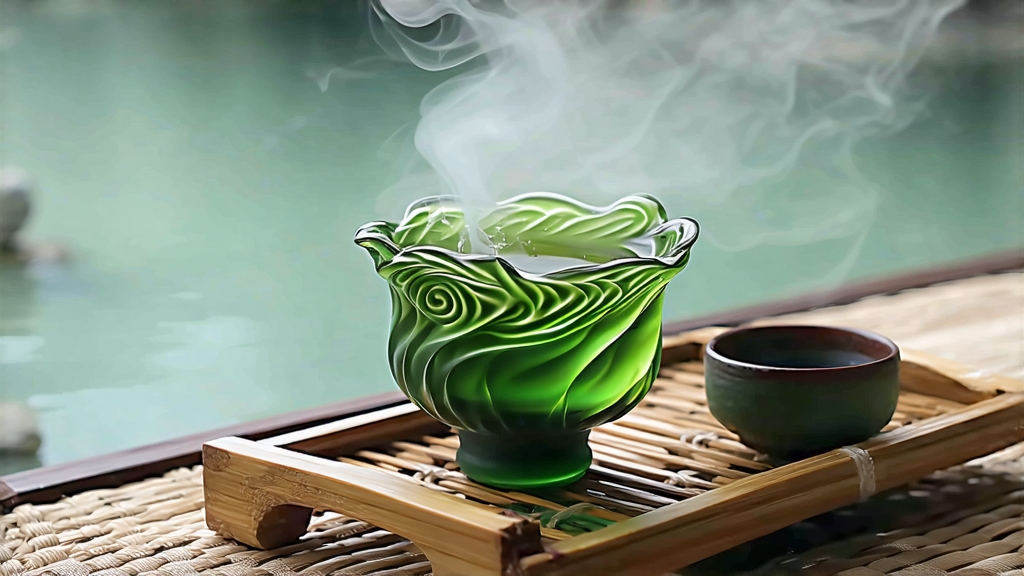
Biluochun, whose name translates literally to “Green Snail Spring,” is one of China’s ten most celebrated teas, yet it remains a quiet jewel outside specialist circles. Grown on the mist-lapped islands and peninsulas of East China’s Taihu Lake, the tea is so delicate that local growers claim the spring breeze can bruise it. Its tiny, spiral-shaped leaves look like sea-snails freshly lifted from jade-colored water; when infused, they uncurl into soft needles that stand upright in the cup, releasing an aroma that connoisseurs describe as a marriage of orchid, ripe peach and mountain air.
The documented history of Biluochun begins in the late Ming dynasty, around the seventeenth century, when a traveling tea monk named Piufa noticed unusually fragrant wild tea shoots on Dongting Mountain. He carried cuttings back to Xiaoshi Temple and taught villagers to roll the leaves against the inside of a hot wok until they curled like fern fiddleheads. The technique tamed the leaf’s grassy edge and intensified its natural sweetness. By the Qianlong era (1736–1795) the tea had entered imperial tribute lists; legend claims the Emperor, on his southern inspection tour, renamed it from “Xia Sha Ren Xiang” (literally “astounding fragrance”) to the more elegant Biluochun after its shape and harvest season.
Strictly speaking, only leaf picked within a fifteen-day window in late March to mid-April, before the Qingming festival, from two mountains—Dongting East and Dongting West—may be called Original Ecotype Biluochun. Yet the name is now borrowed by gardens in Sichuan, Guizhou and Zhejiang where the same cultivar (a small-leaf Camellia sinensis var. sinensis clone known locally as “Biluochun Qunti”) is grown at similar latitude and mist frequency. Purists divide the tea into four grades: Supreme, Special, First and Second, judged primarily by the ratio of downy buds to single leaves and the percentage of broken fragments. Supreme grade contains at least 60 % unopened buds, each no longer than 1.5 cm, covered in silvery trichomes that shimmer like frost under light.
Crafting Biluochun is a race against time and oxidation. Picking starts at dawn when the leaf’s moisture is high and the temperature low; carriers shuttle the baskets to the village alleyways within two hours. There, the leaves are spread on bamboo sieves for a brief withering—no more than thirty minutes—until the edges feel limp to the touch. The critical step is “shaqing” or kill-green: a 180 °C wok is swabbed with fresh tea-seed oil, then the leaves are tossed by hand in 100-gram batches. The motion is a complex push-press-roll-lift cycle repeated 6–7 times over four minutes, during which the artisan judges moisture loss by ear—the crackle should sound like thin ice breaking—and by smell, which shifts from raw pea to fresh corn silk. Immediately after shaqing the leaves are rolled while still above 50 °C; thumb and forefinger pinch the hot mass into a rope, coiling it clockwise against the wok wall. This is where the signature spiral is born. A final low-temperature bake, 60 °C for forty minutes, sets the shape and reduces residual moisture to 4 %, low enough for year-round storage without refrigeration if kept below 20 °C and 50 % humidity.
Water choice is non-negotiable for Biluochun. The classical text “Cha Shu” (1832) recommends “third-spring water from Tiger Hill,” but any soft, neutral spring water with total dissolved solids below 80 ppm will suffice. Heat to 75 °C—just when the kettle forms pin-sized bubbles dubbed “crab eyes.” Use a tall, clear glass or a 150 ml porcelain gaiwan so the foreign eye can watch the leaves dance. A 1:50 leaf-to-water ratio (three grams, 150 ml) is standard. Pour the water along the glass wall to avoid scorching the downy tips, then pause for twenty seconds while the leaves hydrate. The first infusion should be pale jonquil with a sheen that tea men call “oil bloom.” Lift the glass to nose-height; the steam carries a scent that oscillates between apricot blossom and baby sweetcorn. Sip with the lips slightly parted to aspirate; the liquor enters soft, then tightens